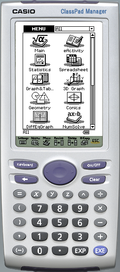- Casio ClassPad 300
-
Casio ClassPad 300 Type Programmable Graphing Manufacturer Casio Calculator Entry mode V.P.A.M. Display Type LCD Dot-matrix Display Size 160×240 dots Programming Programming language(s) BASIC-like Other The Casio ClassPad 300 is a stylus based calculator. HP worked on a pen based calculator called the HP-Xpander, as did Texas Instruments under their PET Project (see TI PLT SHH1), yet both projects were cancelled before they were released to the market. The ClassPad comes with a collection of applications that support self-study, like 3D Graph, Geometry, eActivity, Spreadsheet, etc. A large 160x240 pixel LCD touch screen enables stylus-based operation. There is a strong resemblance between the ClassPad and the older Pocket Viewer line.
The ClassPad 300 allows input of expressions, and displays them as they appear in a textbook. Factorization of expressions, calculation of limit values of functions, and other operations can be performed while viewing the results on a large LCD screen. The ClassPad 300 comes with graphing tools for 3D graphing and drawing of geometric figures.
The user interface of the ClassPad 300 uses a pull-down menu format. Solutions, expressions, and other items can be selected with the tap of the stylus. The ClassPad 300 also supports drag and drop, copy and paste, and other pen-based operations.
An eActivity application allows the creation of eActivities that can include figures, expressions, and explanations.
The ClassPad series is banned from standardized tests including the SAT, the ACT, and the AP Calculus test.[1]
Contents
Product lines
ClassPad 300
This is the first ClassPad series with only 4.5 MB of flash memory.
ClassPad 300 Plus
The Plus series is equipped with a high contrast display, 5.4 MB of flash memory and comes with a standardized Mini-USB port.
ClassPad 330
This series is almost identical to the ClassPad 300 Plus except that the preinstalled firmware has been updated to at least OS 3.02
ClassPad 330-A
The A series was reported to be a version of ClassPad 330 with preinstalled OS 3.03[2]
History
During 1996, CASIO worked on the CAS (Computer Algebra System) and studying Geometry. The CAS was first used in the Casio CFX-9970G then the Casio Algebra FX 2.0, and later formed the core math system for the ClassPad.
In 1999, with the help of many teachers and friends, the idea of the eActivity emerged. It would allow all applications to interact from within one application, and display information in a textbook style.
In 2000 CASIO opened a new office, the CASIO Education Technology M.R.D. Center in Portland, Oregon, USA. They hired engineers familiar with programming PCs and specialists from the education field. Ideas from around the world were now being implemented into the ClassPad by Tokyo R&D and Portland MRD Team.
In 2002 CASIO completed a prototype for the ClassPad. Before the prototype was complete, an emulator was used for testing. The emulator was so good that CASIO decided to include the emulator in the software that was being developed for data transfer. The data transfer and emulator software merged into one product called the ClassPad Manager.
In 2003 CASIO finally released the ClassPad 300.
In 2005 CASIO released the ClassPad 300 Plus featuring more flash memory, a better display and standardized Mini-USB.
In 2007 CASIO released the ClassPad 330 featuring a preinstalled version of OS 3.02 or OS 3.03.
ClassPad OS 3.0
In 2006 CASIO released OS 3.0 for the ClassPad. OS 3.0 featured Laplace and Fourier transform, differential equation graphs, financial functions, AP statistics and parameterized 3D graphs. Subsequent releases were only available for users with OS 3.0 or later.
In 2006 CASIO released OS 3.01 for the ClassPad. OS 3.01 concentrated solely on bug fixing.
In 2007 CASIO released OS 3.02 for the ClassPad. OS 3.02 concentrated solely on bug fixing.
In 2008 CASIO released OS 3.03 for the ClassPad. OS 3.03 featured new probability distribution functions, an extended numeric solver and several user interface improvements.
In 2009 CASIO released OS 3.04 for the ClassPad. OS 3.04 featured an updated spreadsheet application, stat function enhancements and several user interface improvements. Also, there were two hotfix releases for OS 3.04.3000 - namely: OS 3.04.4000[3] and OS 3.04.5000[4]
In 2010 CASIO released OS 3.05 for the ClassPad. OS 3.05 featured new financial functions and an 'on data' option for quartile calculation.
In 2011 CASIO released OS 3.06 for the ClassPad. OS 3.06 featured new imaginary calculation functions and an improved numeric solver. So far, one hotfix release followed: OS 3.06.1000
See also
- Casio 9860 series
- TI-Nspire
- Derive (computer algebra system)
- TI-92 series
- TI-89
- TI-83
- TI-84
- HP-49 series
- HP-Xpander (project was canceled)
References
External links
- Casio Resources and Downloads – CASIO WEW Worldwide Education Website.
- CASIO ClassPad Europa de – Official ClassPad 300 Web site for Casio Europe.
- Universal Casio Forum – Forum for Casio calculators.
- www.classpad.tk – website in Spanish.
- Casio Kingdom – The Casio calculator resource site.
- ClassPad Yahoo Group – Another related forum.
- AULA MATEMATICA DIGITAL – website in Spanish.
- Classpad Help Series – Tutorial with movies to start learning about ClassPad.
- CasioEd – Australian resources for learning maths with Classpad.
Casio calculators Scientific: Scientific Keystroke Programmable: Scientific BASIC Programmable: FX-702P · FX-850PGraphing Programmable: fx-7000G · 9850 series · 9860 series · ClassPad 300 · Casio graphic calculatorsCategories:- Casio calculators
- Graphing calculators
Wikimedia Foundation. 2010.


